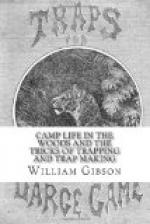[Illustration]
This odd invention will be found to work capitally as a game trap, and the only extra requisite necessary consists of a slab or light board about seven inches wide, and a foot in length. Having selected the spot for the trap, proceed to cut a stiff [Page 62] switch about five feet in length, and having sharpened the larger end to a nice point, insert it firmly into the ground in a slanting direction as our drawing illustrates. Next bend down the tip of the sapling, and resting one end of the board on the ground, catch the tip of the switch against the other end, as our illustration also shows. A little experimenting will soon determine the right place for the board, after which two pegs should be driven in the ground at its edge to hold it against the pressure on the opposite end. This being done fasten a wire noose to the tip of the switch, after which the pen is the only thing required. This should be built of simple little twigs arranged around three sides of the board, leaving the front end open. To set the snare, lower the switch and raising the board slightly at the back end, catch the tip of the springer behind it, afterwards arranging the noose over the platform, and scattering the bait inside. If the trap has been constructed properly and set “fine” it will take but a very slight weight on the platform to lower it from its bearing, the weight of an ordinary bird being sufficient, and the springer thus released will fly forward either catching its victim by the neck or legs, as the case may be. It may sometimes be found necessary to cut a slight notch in the end of the springer to receive the board, but in every case it should be tried several times in order to be sure that it works sensitively.
[Page 63] [Illustration: TRAPS FOR FEATHERED GAME]
[Page 65] BOOK III.
TRAPS FOR FEATHERED GAME.
[Illustration: A]mong the following will be found the various net and cage traps commonly used in the capture of winged game, besides several other unique devices in the shape of box traps, etc., many of which are original with the author of this work and appear in the present volume for the first time in book form. Commonest among bird-catching machines, is the well known invention of
THE SIEVE TRAP.
This device certainly possesses one great advantage:—it is not complicated. Any one possessed of a sieve and a piece of string can get up the trap at two minutes’ notice, and provided he has patience, and can wait for his little bird, he is almost sure to be rewarded for his pains,—if he wait long enough. This of course depends upon circumstances: when the birds are plenty and are not shy, it is a common thing to secure three or four at once in a very few minutes, while at other times an hour’s patient waiting is unrewarded.




